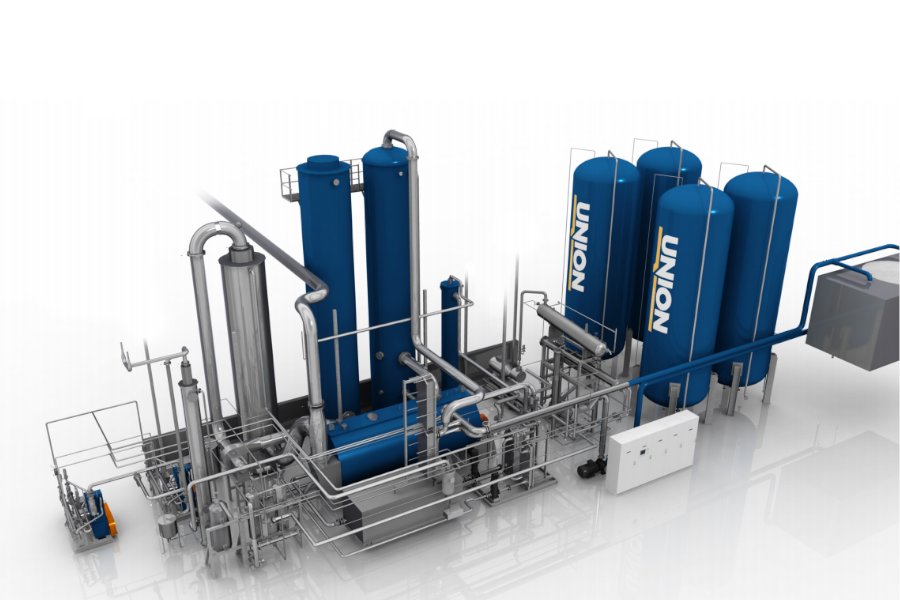- Home
- Case Studies
- Coca Cola Puerto Rico
Company
Coca-Cola Bottlers Puerto Rico
Application
Combustion-based CO2 Self-Generation Plant
Benefits
Reduced the use of diesel fuel by up to 45%. Elimination of PPM (Potassium Permanganate) used as the oxidizing agent in the production of CO2. Top-quality Carbon Dioxide.
FOCUS ON INNOVATIVE CO2 SOLUTIONS AND REDUCED UTILITY COSTS
The major challenge faced by CO2 plant suppliers today is the increased interest from customers in reducing their carbon footprint.
Union Engineering is finding that their customers challenge them on that issue – a challenge Union Engineering is happy to meet; “Instead of just supplying a CO2 plant, we are cooperating with the customers in making solutions.
These solutions are based on our customers’ existing set-up, as well as their future planning of CO2 supply and in line with our customers' internal politics and strategy”, says Sales Manager Lars Klitgaard Pedersen.
CUSTOMER DEMANDS STRENGTHEN
Some of the key success factors for soft drink bottlers in regards to their CO2 use are high purity and stable supply. In this regards local conditions are always an important factor and it is crucial to design a solution that considers local conditions.
In Puerto Rico, Caribbean, Union Engineering won a project from the local Coca-Cola bottler where the assignment was to ensure the bottler's independence from external carbon dioxide suppliers and secure a constant supply of top quality carbon dioxide. Further, the Coca-Cola bottler was facing increased difficulties in purchasing potassium permanganate from the market, a chemical traditionally used as an oxidation agent in the CO2 purification process.
Developing the project Union Engineering and the Coca-Cola bottler focused on designing a plant that would benefit both operating costs and the environment. The final solution which uses a range of Union Engineering’s proprietary purification solutions ended up providing reductions in both fuel and chemical consumption.
REDUCED THE USE OF DIESEL FUEL BY UP TO 45%
“Where a conventional combustion-based CO2 plant consumes approx. 350 Kg diesel/h to produce 1000 Kg of food-grade carbon dioxide, we developed a future-orientated solution in Puerto Rico”, says Lars Klitgaard Pedersen; “By using a part stream of an existing flue gas source, fuel input to the CO2 plant is reduced by up to 45%”.
The flue gas chosen was from the existing steam boilers, which during the steam production produces the CO2-rich flue gas that goes straight into the carbon dioxide plant. When combining the flue gas the Union Engineering plant automatically adjusts the burner according to the quantity of flue gas. The plant is configured to run based on 100% diesel combustion, however, via sensors, the import of the flue gas starts as soon as the steam boilers are working. This set-up ensured Coca-Cola the best possible carbon dioxide production, and the best possible utilization of the flue gas available.
“By using a part stream of an existing flue gas source, fuel input to the CO2 plant is reduced by up to 45%”
- Lars Klitgaard Pedersen - Sales Manager Pentair Union Engineering
ELIMINATION OF PPM (POTASSIUM PERMANGANATE) USED AS THE OXIDIZING AGENT IN THE PRODUCTION OF CO2
Having solved the demands from Coca-Cola regarding an environmentally friendly solution Union Engineering furthermore implemented one of their patented technologies, NOxFlash (Patent Pend.) whereby the traditional use of PPM – which usually is a part of the purification steps – was eliminated.
In CO2 production plants, some of the impurities being most difficult to remove are typically dealt with by scrubbing the feed gas with an aqueous solution of potassium permanganate (PPM). The PPM oxidizes the pollutants into water-soluble substances, which can then be removed as liquid waste from the PPM scrubber. The liquid waste originating from this scrubbing process is however hazardous to the environment and must be incinerated.
Furthermore, PPM is regulated under the United Nations Convention against illicit traffic in narcotic drugs and psychotropic substances of 1988 and it is on the list of dangerous substances according to UN Recommendations on the Transport of Dangerous Goods.
Process Engineer Søren Jensen from Union Engineering Knowledge Center explains; “In the NOx-flash unit, steam and heat both already generated during CO2 production are utilized to remove benzene and the pollutants which otherwise must be eliminated in a PPM scrubber, in an early stage in the production. As a result, high-quality CO2 can be produced at a minimum consumption of expensive and hazardous chemicals.”
“Coca-Cola Puerto Rico Bottlers is pleased not only with the technology and the operational capability of the CO2 plant but is also impressed by the strong support platform and quality of services from Union.”
- Carlos Triguero - Director Coca-Cola Puerto Rico Bottlers
Top-quality Carbon Dioxide
Last but not least, the Coca-Cola plant in Puerto Rico was equipped with a final purification unit, a PUR-D, to ensure improved purity of the carbon dioxide, and the result did not just meet the expectations from the customer but the purity significantly exceeded the applicable requirements. The combination of the NOxFlash and the PUR-D reduced the O2 in the final product to below 5 ppm. Union Engineering completed the commissioning of the new Coca-Cola carbon dioxide plant at the beginning of 2009.
Director Carlos Triguero says; “Coca-Cola Puerto Rico Bottlers is pleased not only with the technology and the operational capability of the CO2 plant but is also impressed by the strong support platform and quality of services from Union”.
Related Products
Pentair CO2 Combustion Based Unit - CBU Plants
Generate CO2 from gas streams based on the combustion of fuels.
NEWS


